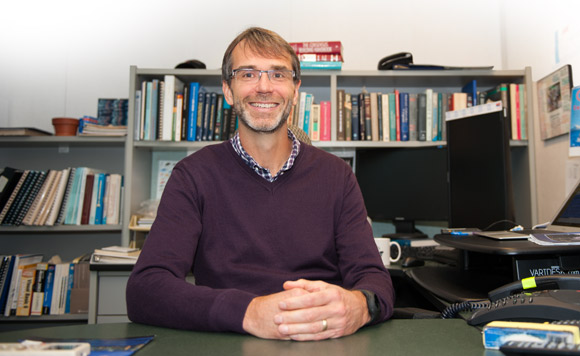The Thirty Meter Telescope (TMT) will be the size of a sports stadium when built. Envisioned as a robust, scientifically efficient system that will address the most compelling astrophysics science questions of our time it will produce images of unmatched reach and sharpness. As Systems Engineering Group Leader for the TMT Project, managed by the TMT Observatory Corporation here at the observatory on the Saanich Peninsula, what is your role in this pre-construction phase?
Systems engineering involves taking a complex system and dividing its design and implementation into smaller manageable pieces. For TMT our team translates the key science goals of the observatory into engineering design and performance specifications for the complete system. We then flow these down to requirements for each of the 32 sub-systems of the observatory that are being built across our partnership. Our team is also responsible for maintaining engineering performance models that predict how the telescope will perform once it is built. We have now finished the design phase and are initiating construction. Our job over the next several years is to be the technical eyes and ears for the project, making sure that the delivered system provides the exceptional science capability that the astronomers are expecting.
The TMT project is a powerful collaboration that represents the astronomy aspirations of a large portion of the world’s population. Can you give us an understanding of how this project and its partners came about.
In the early 2000’s Canada and two separate groups in the USA were studying the feasibility of building optical telescopes with extremely large primary mirrors in the range 20 to 30 metres in diameter, much larger than the current generation of 8 to 10 metre telescopes. It was realized that for a project of this magnitude, an international partnership would be required to make it a reality, so we joined forces in 2004. Later in that decade Japan, China and India recognized the scientific potential of the project and also joined. In early 2015 Canada is expected to make a decision about funding the construction phase of the project. The other partners have already made the financial commitments to build the telescope.
The TMT project is an international partnership involving Canada, the USA, Japan, China, and India. TMT represents a unique technical, industrial, and scientific collaboration that benefits all partners. As we near the construction phase, what critical aspects of the project will Canada provide with respect to the key components of the build?
Canada’s excellence in astronomy research, along with its capability to provide proven world-class facilities and instrumentation through industry, university, and government labs such as the NRC Herzberg observatory in Victoria, put it in an excellent position to play a major role in TMT. Canada’s contributions would include the large 66 m diameter enclosure that provides protection from the elements and the needed environmental conditions for the telescope to achieve excellent image quality. In addition Canada would contribute the instrument that is at the heart of the scientific capability of the observatory. This adaptive optics system is designed to remove the blur of the atmosphere, providing TMT the capability to see objects 150 times fainter than the Hubble Space Telescope with a resolution 10 times sharper.
The site for TMT will be located near existing facilities on Mauna Kea in Hawaii, with construction phase beginning in 2014, and completion early 2024. Can you give a glimpse of what the next 20 years will look like? Would that involve moving to Hawaii at some point?
Over the next few years we will see the foundation, enclosure and telescope structure built at the observatory site. At the same time each of the partner countries will be building the systems that they will contribute to the observatory, including the optics and instrumentation. Once the enclosure and telescope structure are complete we will start installing the optics and technical systems into the telescope. Personally, the next few years will involve working with technical and science teams in all of the partner countries in the development of the observatory systems. Towards the end of this decade I will likely relocate to Hawaii to work on the integration and testing of the observatory.
Canada has a long history of astronomy from the first and largest observatory built in 1918 (Centre of the Universe located on the Saanich Peninsula), to the 1970’s with the CFHT (Canadian-France-Hawaii Telescope) in Hawaii, to the up-coming TMT project (the highest priority in the 2010 Long Range Plan for Canadian Astronomy.) What does this mean for Canada’s role as a leader in technology and research?
Over the last century Canada has consistently provided excellent astronomical facilities for use by our researchers, and TMT naturally follows this progression. Building these facilities has also helped develop cutting-edge technologies and expertise that have provided significant competitive advantages to Canadian industry. Development of astronomical facilities builds bridges and provides for transfer of knowledge between university researchers, government laboratories and industry.
With the development of TMT we are on the verge of a telescope that will enable investigation of science’s major mysteries. How do you think this will this affect the next generation?
In 2024 the telescope will be ready for the first science observations. TMT will provide 100 times the sensitivity of the best existing optical telescope facilities, and it will undoubtedly produce exciting new and unexpected insights into what our universe is made of, how it formed and evolved, and about life elsewhere in the universe. Not only will TMT help answer these questions of deep interest to the public, it will also inspire future generations to pursue careers in science and engineering.
What are the tangible benefits of the international link between Canada and the Pacific Rim? Do you see the technical challenges of TMT leading to new globally competitive, technical capabilities within Canadian industry?
The observatory location on Mauna Kea on the Big Island of Hawaii was chosen because of its exceptional characteristics for astronomical observations. Mauna Kea is centred amongst the partner countries in the Asia-Pacific region. In building TMT we are creating a leading world-class observatory, but we are also building international partnerships. The TMT will have a 50 year operational lifetime, so we are only just starting to see the benefits of these relationships. These will certainly include enhanced technical capabilities within industry for all of the partners.
Scott Roberts is the systems engineering group leader for the Thirty Meter Telescope project. He has undergraduate and graduate degrees from UBC Mechanical Engineering. Scott’s interest in astronomy started with building his own amateur telescope. For the last 20 years he has been developing designs for telescopes and instrumentation for use by Canadian Astronomers. He lives in Saanich with his wife and two teenage daughters, enjoys sailing in local waters and running on park trails with his dog.




